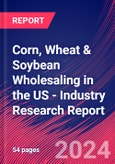Corn, wheat and soybean wholesalers distribute grains, such as corn, rice, wheat, dry beans and soybeans, which are essentials in most Americans' diets. Due to their necessary nature and the fact that households are typically unable to dramatically change their food preferences in the short run, the COVID-19 recession didn't drastically reduce revenue for wholesalers. Many companies endured some decline in sales because of falling demand from retail and manufacturing markets, so they still decided to reduce their capacity. As spending surged during the pandemic recovery, wholesalers, farmers and other industry operators couldn't increase their supply to match demand. Prices of agricultural products, such as corn, wheat and soybeans, rose drastically. Since wholesalers can pass these costs onto consumers, it was a boon for their revenue. The industry faces a new challenge from the war in Ukraine, which has restricted the wheat supply. Easing supply chains have also caused agricultural prices to tank, reducing wholesalers' sales values. While these troubles are serious, corn, wheat and soybean wholesalers receive a lifeline from the federal government, as they subsidize biofuels to reduce carbon emissions. Corn and soybean oils are necessary components of biofuels, so their subsidization boosts spending on these crops and their wholesalers. Overall, revenue for corn, wheat and soybean wholesalers has increased at a CAGR of 4.3% over the five years to 2023, reaching $274.7 billion, and including a revenue drop of 10.5% this year alone.Spill the beans: price appreciation of industry products will boost industry revenue growth
Operators in this industry purchase and distribute grains such as corn, rice, wheat, dry beans, soybeans and other inedible beans. They distribute these products to food processors, industrial manufacturers, animal feed producers, exporters and other buyers. The industry includes players that operate grain elevators for bulk wholesale, but excludes players that operate grain elevator establishments for storage. Wholesalers of field and garden seeds are also excluded from this industry.
This report covers the scope, size, disposition and growth of the industry including the key sensitivities and success factors. Also included are five year industry forecasts, growth rates and an analysis of the industry key players and their market shares.
Table of Contents
About This Industry
Industry Performance
Products & Markets
Competitive Landscape
Operating Conditions
Key Statistics
Companies Mentioned (Partial List)
A selection of companies mentioned in this report includes, but is not limited to:
- Archer-Daniels-Midland Co
- Chs Inc.
- Cargill, Incorporated
Methodology

LOADING...








